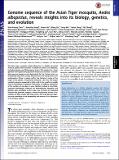Genome sequence of the Asian Tiger mosquito, Aedes albopictus, reveals insights into its biology, genetics, and evolution
Author(s)
Chen, Xiao-Guang; Jiang, Xuanting; Gu, Jinbao; Xu, Meng; Wu, Yang; Deng, Yuhua; Zhang, Chi; Bonizzoni, Mariangela; Dermauw, Wannes; Vontas, John; Armbruster, Peter; Huang, Xin; Yang, Yulan; Zhang, Hao; He, Weiming; Peng, Hongjuan; Liu, Yongfeng; Wu, Kun; Chen, Jiahua; Lirakis, Manolis; Topalis, Pantelis; Van Leeuwen, Thomas; Hall, Andrew Brantley; Jiang, Xiaofang; Thorpe, Chevon; Mueller, Rachel Lockridge; Sun, Cheng; Yan, Guiyun; Tu, Zhijian Jake; Fang, Xiaodong; James, Anthony A.; Waterhouse, Robert; ... Show more Show less
DownloadChen-2015-Genome sequence of t.pdf (1.042Mb)
PUBLISHER_POLICY
Publisher Policy
Article is made available in accordance with the publisher's policy and may be subject to US copyright law. Please refer to the publisher's site for terms of use.
Terms of use
Metadata
Show full item recordAbstract
The Asian tiger mosquito, Aedes albopictus, is a highly successful invasive species that transmits a number of human viral diseases, including dengue and Chikungunya fevers. This species has a large genome with significant population-based size variation. The complete genome sequence was determined for the Foshan strain, an established laboratory colony derived from wild mosquitoes from southeastern China, a region within the historical range of the origin of the species. The genome comprises 1,967 Mb, the largest mosquito genome sequenced to date, and its size results principally from an abundance of repetitive DNA classes. In addition, expansions of the numbers of members in gene families involved in insecticide-resistance mechanisms, diapause, sex determination, immunity, and olfaction also contribute to the larger size. Portions of integrated flavivirus-like genomes support a shared evolutionary history of association of these viruses with their vector. The large genome repertory may contribute to the adaptability and success of Ae. albopictus as an invasive species.
Date issued
2015-11Department
Broad Institute of MIT and Harvard; Massachusetts Institute of Technology. Computer Science and Artificial Intelligence LaboratoryJournal
Proceedings of the National Academy of Sciences of the United States of America
Publisher
National Academy of Sciences (U.S.)
Citation
Chen, Xiao-Guang et al. “Genome Sequence of the Asian Tiger Mosquito, Aedes Albopictus , Reveals Insights into Its Biology, Genetics, and Evolution.” Proceedings of the National Academy of Sciences 112.44 (2015): E5907–E5915.
Version: Final published version
ISSN
0027-8424
1091-6490